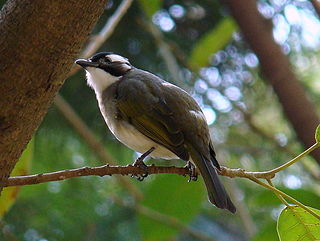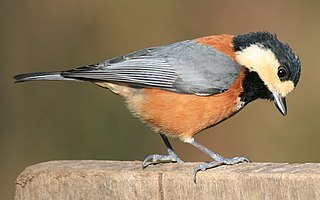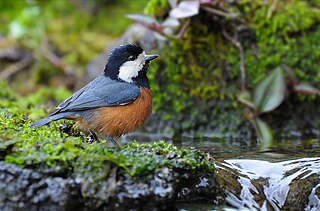
The white-backed woodpecker is a Eurasian woodpecker belonging to the genus Dendrocopos.

The painted buttonquail is a species of buttonquail, the family Turnicidae, which resemble, but are unrelated to, the quails of Phasianidae. This species is resident in Australia where numbers are believed to be in decline. A subspecies, the Abrolhos painted buttonquail, is endemic to the Houtman Abrolhos islands.

The light-vented bulbul, also called the Chinese bulbul, is a species of bird in the bulbul family found in central and southern China, Hong Kong, Macao, northern Vietnam, southern Japan and Taiwan, with occasional records from South Korea. A common species of songbird that favors lightly wooded habitats, it can frequently be seen in towns, suburbs and urban parks within its range.

The pin-striped tit-babbler, also known as the yellow-breasted babbler, is a species of bird in the Old World babbler family Timaliidae that is found in South and Southeast Asia.

The white-winged black tit is a passerine bird in the tit family Paridae. It is also known as the white-winged tit, dark-eyed black tit or northern black tit. The species was first described by Eduard Rüppell in 1840.
The Daito varied tit is an extinct subspecies of the varied tit. It was formerly found on Kita Daitō-jima and Minami Daitō-jima in the Daitō group east of the Okinawa Islands, but became extinct around 1940. It seems that the last specimens collected were Kuroda's types taken in 1922, and that the last confirmed sighting was in 1938. Searches in the 1980s and subsequently failed to find any. The subspecies became extinct following the habitat destruction brought about by settlement and construction activity in the 1930s.

The yellow-faced grassquit is a passerine bird in the tanager family Thraupidae and is the only member of the genus Tiaris. It is native to the Central America, South America, and the Caribbean.

The varied tit is a perching bird from the tit family, Paridae. It occurs in the eastern Palearctic in Japan, Korea, and locally in northeastern China and extreme southeastern Russia.

Ijima's leaf warbler is a species of Old World warbler in the family Phylloscopidae. The species is native to Japan, where it has been designated a Natural Monument under the 1950 Law for the Protection of Cultural Properties, with records also from Taiwan and the Philippines.

The elegant tit is a species of bird in the tit family Paridae endemic to the Philippines.

The yellow tit, Taiwan yellow tit, or Formosan yellow tit is a species of bird in the family Paridae. It is endemic to central Taiwan.

The white-fronted tit is a species of bird in the family Paridae. It is endemic to the Philippines found in the islands of Luzon and Mindanao. Its natural habitat is tropical moist lowland forests. It is threatened by habitat loss.

The Gough finch or Gough bunting, is a critically endangered species of songbird.

Sittiparus is a genus of birds in the tit family Paridae. The species in the genus were formerly included in Parus but were moved to Sittiparus when Parus was split into several resurrected genera following the publication of a detailed molecular phylogenetic analysis in 2013. The genus Sittiparus had originally been erected by the Belgium politician and naturalist Edmond de Sélys Longchamps in 1884 with the varied tit as the type species.

Carp's tit or Carp's black tit, is a species of bird in the family Paridae. Some authors consider it a subspecies of the black tit. It is found throughout the Namibian savanna woodlands and the southern Angolan mopane woodlands.

The white-shouldered black tit, also known as the pale-eyed black tit, is a passerine bird in the tit family. It breeds in a belt across Africa from Senegal in the west to Kenya and Ethiopia in the east. It is sometimes considered conspecific with the more southerly white-winged black tit Melaniparus leucomelas and, like that species, it is mainly black with a white wing patch, but differs in that it has a pale eye.

The silver-throated bushtit or silver-throated tit is a species of passerine bird in the family Aegithalidae, widespread throughout the temperate forests of Central, East and parts of North and Western China. The bird's native habitats are mainly along the middle/lower Yangtze and Yellow River basins, although there is also a small southwestern habitat extension in Yunnan along the Lancang valley within the Hengduan Mountains. It has two recognized subspecies.

Owston's tit is a small passerine bird in the tit family Paridae that is endemic to the southern Izu Islands south of Japan.

The chestnut-bellied tit is a small passerine bird in the tit family Paridae that is endemic to Taiwan.

Orii Hyōjirō was a Japanese specimen collector of birds and mammals. At least a hundred new species and subspecies were described based on the type specimens he collected, a 2014 review putting the total, among taxa currently recognized, at 14 species and 41 subspecies of mammal, and 6 species and 68 subspecies of bird. The 7 mammal and 10 bird taxa named in honour of "Orii of the Orient", as he came to be known, include the Ryūkyū shrew and now-extinct Daitō varied tit.



















